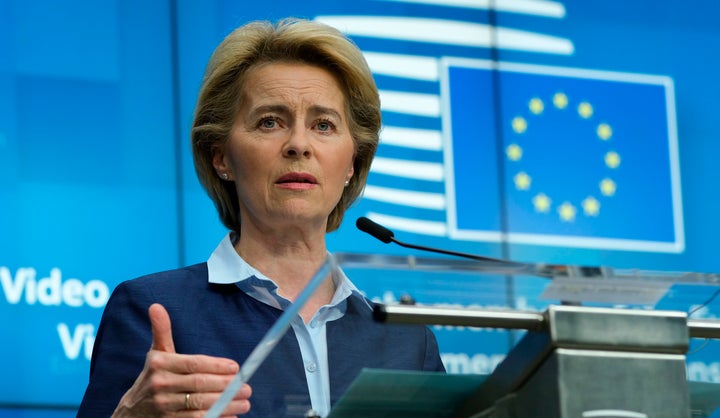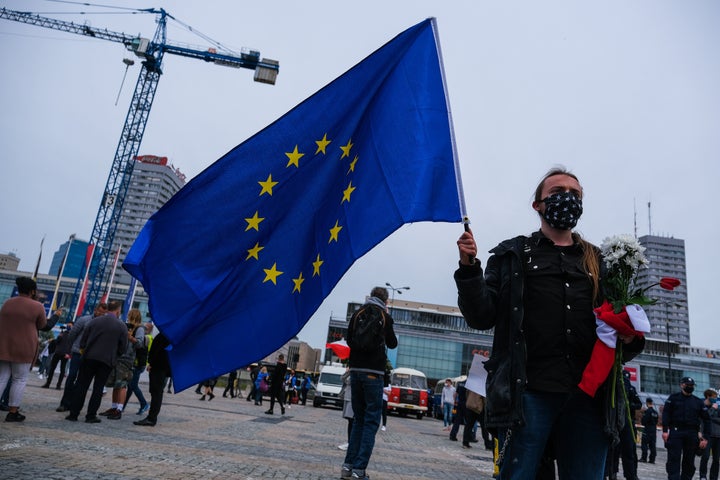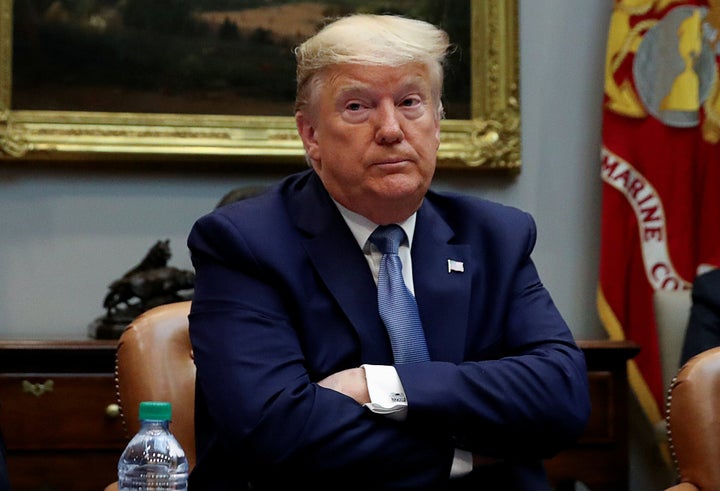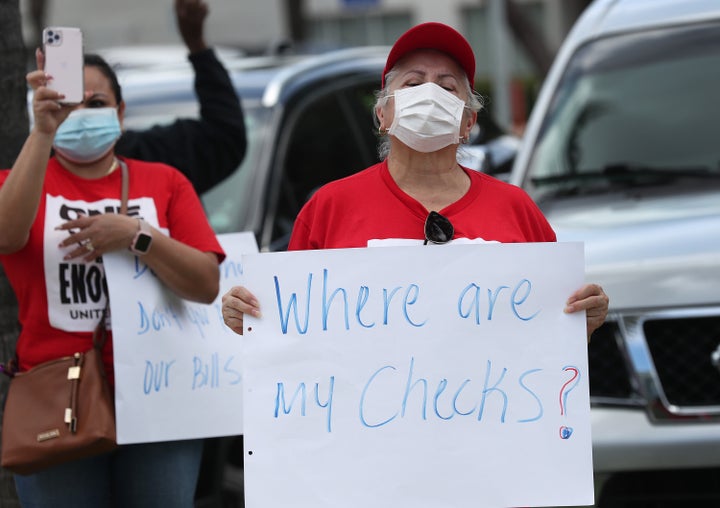Last week, European Union leaders took a historic step that could help solidify the future of the bloc and allow it to mount a strong economic response to the coronavirus pandemic.
The move stands in sharp contrast to the United States, where a patchwork of government aid programs has been mired in partisan infighting, leaving millions of people desperate for help.
On its face, the EU’s proposed 750 billion euro (approximately $825 billion) rescue plan would provide much-needed relief to member states whose economies have been hammered by the outbreak.
In a larger sense, by asserting the authority of the EU’s central government and acknowledging the mutual economic interests of European nations, the blueprint represents a major milestone in a half-century of European integration.
“This is about all of us, and it is way bigger than any one of us,” Ursula von der Leyen, president of the European Commission, told European Parliament members in a speech last Wednesday in Brussels. “This is Europe’s moment.”
Under the relief proposal, funds would be split into two pots. In one, 500 billion euros would be distributed as grants — money that would not need to be repaid — to countries based on their recovery needs. Much of the money would go to Italy and Spain, the EU nations most affected by the pandemic.
The rest of the funds, 250 billion euros, would be offered as loans to countries that apply for them, and would have certain provisions attached.
“We either all go it alone, leaving countries, regions and people behind and accepting a union of haves and have-nots, or we walk that road together,” von der Leyen said.

If the EU’s 27 member states approve the plan in the coming months, it could end months of squabbling over how to fund a recovery that has exposed political and economic fault lines across the continent.
Indeed, in the early days of the pandemic, national interests seemed to trump larger European ideals, leaving the future of the EU increasingly in doubt.
Countries rushed to close their borders and horde stockpiles of medical supplies. In early March, when Italy requested face masks and other medical gear through the European Union’s civil protection mechanism, EU member states responded with silence.
And in the face of an unprecedented economic crisis, with businesses shuttered and millions of people out of work, long-standing rifts between southern countries like Italy and Spain and more fiscally conservative northern countries, such as Austria, Sweden, Denmark and the Netherlands (also known as the “frugal four”), threatened to tear the EU apart.
“It’s Europe’s time to act,” Spain’s prime minister, Pedro Sánchez, said in a national address in March. “Europe is at risk.”
“Europe must demonstrate that it is able to respond to this historic call,’’ Italian Prime Minister Giuseppe Conte said. “I will fight until the last drop of sweat, until the last gram of energy, to obtain a strong, vigorous, cohesive European response.”
Those tensions have not completely disappeared. Indeed, the “frugal four” northern nations, which have argued against grants, have described the EU plan as a starting point for negotiations.
“There are countries that must pay, like the Netherlands, the Swedes, the Danes and us,” Austrian Chancellor Sebastian Kurz said. “We therefore, out of responsibility to our taxpayers, say clearly that we are in favor of loans.”
If the proposal is approved, however, it will represent a victory for the pan-European project and a repudiation of the rising nationalism and calls for austerity that have been echoing across the continent.

The United States, by contrast, has taken a far more divided approach to dealing with the economic fallout from the pandemic.
Since the early days of the crisis, Democrats and Republicans have clashed over what form federal relief should take — and how generous any bailout should be.
In March, Congress passed a $2.2 trillion relief package, the largest in U.S. history, but Democrats have argued that even that figure is not nearly enough.
Amid calls for additional relief, however, the Republican-led Senate took a one-week vacation in May.
Senate Majority Leader Mitch McConnell said last month that he wanted to “pause” before considering more federal stimulus money.
“I don’t think we have yet felt the urgency of acting immediately,” he said.
Last week, the U.S. Labor Department reported that more than 40 million Americans had filed for unemployment benefits since the pandemic intensified in mid-March.
On Thursday, House Speaker Nancy Pelosi sharpy criticized McConnell for delaying further relief.
“We need a pause? Tell that to the virus,” Pelosi said. “Is the virus taking a pause?”

President Donald Trump, meanwhile, has also used the economic crisis to push his own priorities.
As governors have pleaded for federal assistance, Trump has suggested that he might approve funding only for states that agree to assist in his efforts to crack down on undocumented immigrants.
He has said that bailouts for Democratic states are unfair to Republicans, and accused Democratic governors of mismanaging their states’ finances.
“All the states that need help — they’re run by Democrats in every case,” Trump said last month. “I don’t think the Republicans want to be in a position where they bail out states that are — that have been mismanaged over a long period of time.”

He has also used the crisis to try to burnish his own image.
In April, the Treasury Department ordered for Trump’s name to be printed on stimulus checks being mailed to tens of millions of Americans — a move that potentially led to delays in the money being sent.
Trump has also indicated that he wants praise from governors in return for federal aid — compliments that he can potentially use in campaign ads in the run-up to the presidential election in November.
While nations in Europe are working to put their differences aside in order to mount a robust and coordinated response to the crisis, lawmakers in the United States are becoming exasperated.
“This hyperpartisan Washington environment is toxic for this country,” New York Gov. Andrew Cuomo said last week following a meeting with Trump, with whom he has clashed throughout the pandemic.
Cuomo called on Republicans to approve additional funding for state and local governments.
“Pass a piece of legislation that is honorable and decent and does the right thing for all Americans,” he said. “Why is that so hard?”
With reporting from HuffPost Italy, HuffPost Spain and Reuters.
- Stay up to date with our live blog as we cover the COVID-19 pandemic
- 7 essential pieces of relationship advice for couples in quarantine
- What you need to know about face masks right now
- How to tell if you need to start doing online therapy
- Lost your job due to coronavirus? Here’s what you need to know.
- Parenting during the coronavirus crisis?
- The HuffPost guide to working from home
- What coronavirus questions are on your mind right now? We want to help you find answers.
- Everyone deserves accurate information about COVID-19. Support journalism without a paywall — and keep it free for everyone — by becoming a HuffPost member today.

